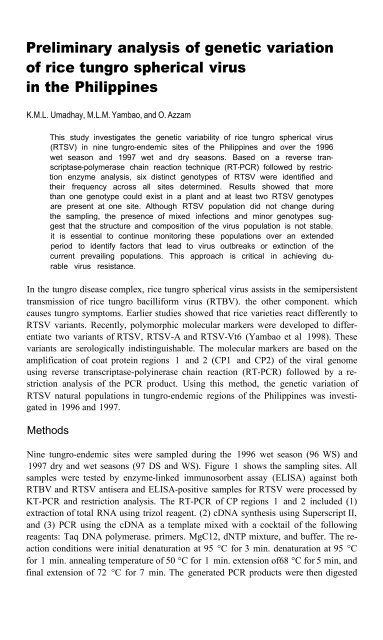Rice tungro disease management - IRRI books - International Rice ...
Rice tungro disease management - IRRI books - International Rice ...
Rice tungro disease management - IRRI books - International Rice ...
Create successful ePaper yourself
Turn your PDF publications into a flip-book with our unique Google optimized e-Paper software.
Preliminary analysis of genetic variationof rice <strong>tungro</strong> spherical virusin the PhilippinesK.M.L. Umadhay, M.L.M. Yambao, and O. AzzamThis study investigates the genetic variability of rice <strong>tungro</strong> spherical virus(RTSV) in nine <strong>tungro</strong>-endemic sites of the Philippines and over the 1996wet season and 1997 wet and dry seasons. Based on a reverse transcriptase-polymerasechain reaction technique (RT-PCR) followed by restrictionenzyme analysis, six distinct genotypes of RTSV were identified andtheir frequency across all sites determined. Results showed that morethan one genotype could exist in a plant and at least two RTSV genotypesare present at one site. Although RTSV population did not change duringthe sampling, the presence of mixed infections and minor genotypes suggestthat the structure and composition of the virus population is not stable.it is essential to continue monitoring these populations over an extendedperiod to identify factors that lead to virus outbreaks or extinction of thecurrent prevailing populations. This approach is critical in achieving durablevirus resistance.In the <strong>tungro</strong> <strong>disease</strong> complex, rice <strong>tungro</strong> spherical virus assists in the semipersistenttransmission of rice <strong>tungro</strong> bacilliform virus (RTBV). the other component. whichcauses <strong>tungro</strong> symptoms. Earlier studies showed that rice varieties react differently toRTSV variants. Recently, polymorphic molecular markers were developed to differentiatetwo variants of RTSV, RTSV-A and RTSV-Vt6 (Yambao et al 1998). Thesevariants are serologically indistinguishable. The molecular markers are based on theamplification of coat protein regions 1 and 2 (CP1 and CP2) of the viral genomeusing reverse transcriptase-polyinerase chain reaction (RT-PCR) followed by a restrictionanalysis of the PCR product. Using this method, the genetic variation ofRTSV natural populations in <strong>tungro</strong>-endemic regions of the Philippines was investigatedin 1996 and 1997.MethodsNine <strong>tungro</strong>-endemic sites were sampled during the 1996 wet season (96 WS) and1997 dry and wet seasons (97 DS and WS). Figure 1 shows the sampling sites. Allsamples were tested by enzyme-linked immunosorbent assay (ELISA) against bothRTBV and RTSV antisera and ELISA-positive samples for RTSV were processed byKT-PCR and restriction analysis. The RT-PCR of CP regions 1 and 2 included (1)extraction of total RNA using trizol reagent. (2) cDNA synthesis using Superscript II,and (3) PCR using the cDNA as a template mixed with a cocktail of the followingreagents: Taq DNA polymerase. primers. MgC12, dNTP mixture, and buffer. The reactionconditions were initial denaturation at 95 °C for 3 min. denaturation at 95 °Cfor 1 min. annealing temperature of 50 °C for 1 min. extension of68 °C for 5 min, andfinal extension of 72 °C for 7 min. The generated PCR products were then digested
















